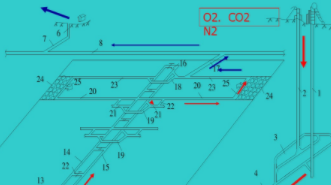
当前课程知识点:心理学之旅 > 第11章 人格 > 第39讲 了解人格—人格测验. > 第39讲 了解人格—人格测验
请看一下这幅图片
Please take a look at this picture
在这幅图片中“你看到了什么”
"What do you see on this picture?"
“让你想起了什么”
"What does it remind you of?"
这是瑞士精神病学家罗夏克
This is a question of the Ink-blot Test
在1921年设计的罗夏克墨迹测验的一个题目
designed by Hermann Rorschach a Swiss psychiatrist, in 1921
这样的图片有10张
There are 10 such pictures
所有图片都是对称的墨迹图片
all of which are symmetrical ink pictures
其中黑白和彩色的各有5张
including 5 in black and white and 5 in color
让受测者看这些图片
He let the subjects look at these pictures
然后回答上面的问题
and then answer the above questions
用来测量人的人格
to measure people's personality
人格测量有很多方法
There are many ways to measure personality
罗夏克墨迹测验
Rorschach Ink-blot Test is a kind of projective test
是以精神分析理论为依据的投射测验的一种
based on psychoanalytic theory
根据精神分析理论
According to psychoanalytic theory
人的无意识欲望
people's unconscious desire can't enter into consciousness
由于受社会道德和超我的压制而无法进入意识
because of the repression by the social morality and superego
无法被我们觉察到
and can't be aware of by us
但如果给受测者一些模棱两可的刺激
However, if we give the subjects some ambiguous stimuli
让他们用任意方式进行解释
and let the subjects explain them in any way
测验材料就像一块幕布
the test material is like a piece of screen
受测者就会把他特有的思想过程
and the subject will "project" his unique thought process
需要 焦虑和矛盾等“投射”在幕布上面
need, anxiety and contradiction on the screen
还有一种投射测验
Another projective test
就是美国心理学家默里在1938年编制的主题统觉测验
is the Thematic Apperception Test developed by Murray in 1938
这个测验包括30张情景模糊的图片
The test included 30 blurred pictures
还有一张空白图片
and a blank picture
要求受测者根据图片讲述一个故事
The subjects are asked to tell a story according to the pictures
包括情境中的人在干什么
including what the people in the situation are doing
想什么 故事是怎么开始的 是怎么结尾的
what they are thinking, how the story starts and ends
根据受测者编的故事
According to the stories made up by the subjects
分析受测者的需要 动机和人格特征
the needs, motivations and personality characteristics of the subjects were analyzed
心理测量的目标是得到可靠而又有效的结果
The goal of psychological measurement is to get reliable and valid results
也就是要有信度和效度
that is, to have reliability and validity
信度就是重复测量能得到一致的结果
Reliability means the results of repeated measurement are consistent
效度就是能不能得到想要测量的东西
validity means getting what you want to measure
那么两种投射测验的信度和效度怎么样呢
What about the reliability and validity of the two projective tests?
罗夏克墨迹测验在诊断
The Rorschach Ink-blot Test
某些类型的心理障碍时是有效的
is effective in the diagnosis of some types of mental disorders
主题统觉测验
and the Thematic Apperception Test
在研究个体成就动机方面很有效
is very effective in the study of individual achievement motivation
但就总体来说
But on the whole
两种测验的信度不高
the reliability of the two tests is not high
也就是重复测量的结果不一致
that is, the results of repeated measurement are inconsistent
这样就很难保证测验的效度
so it is difficult to ensure the validity of the tests
还有一个容易发生的问题
Another problem that is easy to happen
就是分析师经常对受测者的反应
is that analysts often make too subjective diagnosis and inference
做出过于主观的诊断和推论
about the response of the subjects
所以受到强烈质疑
so the tests are strongly questioned
除了投射测验
In addition to the projective test
现在应用更加广泛
the more widely used test
信度和效度更好的测验是自陈式问卷
with better reliability and validity is self-report questionaire
又叫做人格量表
also known as personality inventory
这是一种客观测验
This is an objective test
让被试按自己的意见
in which the subjects according to their own opinions
对自己的人格特质进行评价
evaluate their personality traits
最常使用的人格测量工具是
The most commonly used personality measurement tool
明尼苏达多项人格测验(MMPI)
is Minnesota Multiphasic Personality Inventory (MMPI)
这个测验是美国明尼苏达大学的
This test was developed by
哈萨威和麦克金利在1942年编制的
Hathaway and McKinley of the University of Minnesota in 1942
它的主要目的是根据精神病学的经验效标
Its main purpose was to diagnose individuals
来对个体进行诊断
according to the experience criterion of psychiatry
最初的测验由566个题目组成
The initial test consisted of 566 questions
其中有16个题目是重复的
16 of which were repetitive
所以实际上有550个题目
so there were actually 550 questions
受测者对每个题目回答“是”“否”或“不肯定”
The subjects answered "yes", "no" or "not sure" to each question
比如下面的题目
For example, the following questions:
我相信有人反对我
I believe there are people against me
要求回答是 或否
Answer yes or no
每隔几夜我就会做噩梦
I have nightmares every few nights
要求回答是 或否
Answer yes or no
这个量表不同于其他的人格问卷
This scale is different from other personality questionnaires
因为它的编制完全采用了实证的方法
because it is completely empirical
量表是否采用某个题目
Whether the scale uses a certain question
完全取决于这个题目能否清楚的区分两个群体
depends on whether it can clearly distinguish two groups
比如精神分裂症病人和正常人
such as schizophrenics and normal people
MMPI有10个临床量表
MMPI has 10 clinical scales
这10个临床量表分别是
which are
疑病症
Hypochondriasis,Hs
抑郁症
Depression,D
癔病
Hysteria,Hy
精神变态
Psychopathic deviate,Pd
男性化-女性化
Masculinity-femininity,Mf
妄想症
Paranoia,Pa
精神衰弱
Psychasthenia,Pt
精神分裂症
Schizophrenia,Sc
轻躁狂
Hypomania,Ma
社会内向
Social introversion,Si
每个量表都能区分一个具体的
Each scale can distinguish
临床群体和正常的组
a specific clinical group from a normal group
比如第一个分量表
For example, the first subscale
能把疑病症病人和正常人区分开
can distinguish hypochondriac patients from normal people
另外还包含一个效度量表
In addition, a validity scale is also included
用来测量受测者是否做出不可信的回答
to measure whether the subjects make untrustworthy answers
比如是不是不诚实 是不是粗心 防御或逃避等
such as dishonesty, carelessness, defense or evasion
所以 在解释MMPI的测量结果时
Therefore, when interpreting the measurement results of MMPI
首先要检查效度量表
we should first check the validity scale
看看测量本身是否有效
to see whether the measurement itself is effective
然后再看临床量表的分数
and then look at the clinical scale score
20世纪80年代
In the 1980s
MMPI进行了一次大修订 这就是MMPI-2
MMPI was greatly revised, with the result of MMPI-2
修订了语言和内容
The language and content was revised
增加了15个内容量表
and 15 content scales were added
这些量表分别测量了15种临床相关主题
These scales measure 15 clinical related subjects
可以对正常人进行测试
which can measure normal people
在附加学习材料中
In the additional learning materials
我们还准备了评估五因素模型的NEO-PI量表
we also prepared the NEO-PI scale to evaluate the five factor model
大家可以去学习
which you can learn
好 今天的内容就到这里
OK, that's all for today
现在回顾一下主要内容
Now let's review the main content
今天我们讲了人格的两类测量方法
Today we talk about two kinds of personality measurement methods
一类是投射测验
one is projective test
主要包括罗夏克墨迹测验
which mainly includes Rorschach Ink-blot Test
和主题统觉测验
and the Thematic Apperception Test
这类测验的信度和效度很难保证
The reliability and validity of these tests are difficult to guarantee
常用的人格测验是自陈式问卷
The commonly used personality test is self-report questionaire
我们主要介绍了MMPI
and we talk about MMPI
下次课我们会谈到
Next time we will talk about
美国人为什么普遍自我感觉良好
why Americans generally feel good about themselves
好 下次再见
OK, see you next time
-第2讲 理性之光—心理学是一门科学
-第3讲 寻找事实—心理学的研究方法
-第1章 作业
-第4讲 捷足先登—冯特创立心理学
-第5讲 心灵深处—弗洛伊德的精神分析理论
-第6讲 横空出世—华生与行为主义
-第7讲 融合与发展—心理学的新趋势
-第2章 作业
-第8讲 认知的第一步—感觉及其规律
-第9讲 获取信息—感觉的功能
-第10讲 超越元素—知觉的特性
-第11讲 感知三维世界—深度知觉
-第3章 作业
-第12讲 解决信息混乱—意识的功能
-第13讲 并不平静—睡眠
-第14讲 异常状态—梦、催眠与冥想
-第4章 作业
-第15讲 行为的变化—什么是学习?
-第16讲 建立联结—经典条件作用
-第17讲 行为的塑造—操作条件作用
-第18讲 不必参与的学习—观察学习
-第5章 作业
-第19讲 经验的积累—什么是记忆?
-第20讲 永不消逝的信息—长时记忆
-第21讲 非故意的谎言—记忆重构
-第22讲 转瞬即逝—短时记忆和感觉记忆
-第6章 作业
-第23讲 人类的荣耀—语言
-第24讲 策略与定式—问题解决
-第25讲 并非总是理性—推理与判断
-第7章 作业
-第26讲 行为的动力—动机及其来源
-第27讲 吃还是不吃?—饮食的生理与心理
-第28讲 追求成功的动力—成就动机
-第8章 作业
-第29讲 生命的色彩—情绪及其功能
-第30讲 生命色彩的解读—情绪理论
-第31讲 情绪双刃剑—压力
-第32讲 改变自己—压力应对
-第33讲 创造灿烂人生—幸福有方法
-第9章 作业
-第34讲 你有多聪明?—智力及其测量
-第35讲 因素及其超越—智力理论
-第36讲 遗传、教育、文化—智力的族群差异
-第10章 作业
-第37讲 千人千面—人格的概念和特征
-第38讲 描述差异—类型说与特质说
-第39讲 了解人格—人格测验.
-第40讲 膨胀的自我—自尊运动
-第11章 作业
-期末考试

